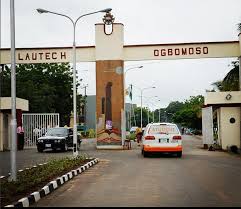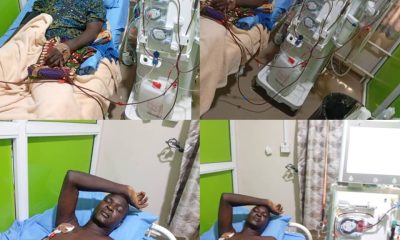News
LAUTECH: The Joint Business Gone Terrible

By Adebayo Rasheed Mabayoje
The ownership of the Ladoke Akintola University of Technology, LAUTECH, has always been a source of conflict between the two-owner states, Oyo and Osun, especially after the latter established her own, Osun State University or UNIOSUN. The government of Oyo State wants Osun to transfer full ownership of the University to it while the other party disagrees. This conflict grew intense in 2010 under ex-Governor Adebayo Alao-Akala of Oyo State and the Osun State counterpart, Olagunsoye Oyinlola.
The feud, which was resolved eventually after series of intervention by notable political icons and the National Universities Commission, has been recurrent at the emergence of every new government even when the governors share political membership.
The feud is usually sparked off by arguments about financial responsibilities. Both owners have pointed fingers at each other regarding failure to meet up to provision of grants and other financial roles to the school. However, available records show that between 2011 and 2019 Osun Government has committed up to 26b Naira, as against Oyo’s 4b Naira, as statutory subvention to the LAUTECH.
This is even as most of the University’s teaching and research structures, as well as the administration are situated in, and run from Ogbomoso, including the central administration of the University.
The implication of this is that the “gown-to-town” benefits of LAUTECH are mostly to the full advantage of the Oyo State Government, and specifically by the Ogbomoso town. Medium estate business flourishes in the town close to three decades running because of the fact that all the campuses of LAUTECH, but one, are established in Ogbomoso town.
The town situates seven faculties and the Post-graduate school of LAUTECH, where courses are taught in various fields of pure and applied science, medicine, agriculture, engineering and technology, environmental science. At least 300 administrative staff and more than 25,000 students of the school pay rents to house owners in Ogbomoso annually . In turn, these estate business operators pay taxes and levies, which adds to the revenues of the Oyo State Government monthly and annually.
Only the College of Health Science campus of LAUTECH is located in Osogbo, Osun State. It houses the 3-years clinical study for MBBS, Medical Laboratory Science and Nursing students which are just about a thousand.
Distastefully, a part of this lone structure of the institution is taken out of Osun state and is established in Ogbomoso. Specifically, the Pre-clinical years of study of the courses in the College of Health Science hold at the main campus in Ogbomoso.
THE FIFTH COLUMNISTS
When General Emilio Mola was leading four columns of troops towards Madrid during the 1936-1939 Spanish civil war, he declared that he had a “fifth column” inside the city. At that time, observers of the feud surrounding LAUTECH were not in existence. However, today, they appreciate how General Mola’s use of the expression, “fifth columnist”, best describes the undermining tendencies of some people, which have regularly surfaced almost at the beginning of new administration(s) in Osun and Oyo States with respect to the joint ownership of LAUTECH.
A plausible idea is that some overt or clandestine actions and activities of some partisan groups are aimed at ensuring that the objective of the founding fathers. regarding the joint ownership of LAUTECH is thwarted. This would be so where these fifth columnists are being tempted by what opinion moulders refer to as “structure reality”.
As opposed to the joint ownership idea which is mutually held and operated cognitively, the “structure reality” of the matter of LAUTECH ownership is the sum or aggregate of all that is real or existent of the buildings and structural facilities and management of the University, all of which are situated in Ogbomoso, Oyo State. According to this school of thought, such is the temptation factor by which the fifth columnists are being encouraged. The plan is to frustrate the other party, the Osun State Government, whose stake, infrastructure wise, is almost nothing.
It is thus reasonable to put into perspectives, what the stake looks like for the Osun State government. Only one, out of the entire structure of the university, is situated in Osun state. In the same vein, more than 90 per cent of the students and staff population of the school, fall in the Oyo State divide.
And going by the records of the financial commitments of the governments of the two states between 2011-2019, Osun government could be said to have more unnecessarily deployed resources to the joint-ownership course. This is, more so, with respect to the paltry 4b Naira subvention records of the Oyo State counterpart against the Osun’s contributions so far.
The 26b Naira subvention record that the Osun government committed within the periods would have made gargantuan impacts if such funds were deployed to the development of the polytechnics, colleges of education owned by government, including the Osun State University, as well as other tertiary institutions in the state.
INTERNAL REVENUE GENERATION OF BOTH UNIVERSITIES
The National Universities Commission, NUC, approved the establishment of the Osun State University on December 21, 2006, as the 30th State University and the 80th in the Nigerian university system. This record shows that the contentious LAUTECH had been established, 16 years earlier, with records of about five convocation.
Current population of LAUTECH’s regular students is about 35,000 as against UNIOSU”s 15,000. Clearly, the former is at greater advantage with regards to revenue generation. Ironically, this relatively older university always go cap-in-hand for funds to pay salaries of its workers and for other expenditures. So, where goes the generated revenues running to billions of Naira every academic session?
While the Osun State Government commits billions of Naira annually to the running of LAUTECH, a joint institution, it hardly received request for subvention from the Osun State University management. This is because with seven colleges in six campuses located in the six geopolitical zones of Osun State, enough revenues are generated and are equally expended judiciously, including the payment of staff salaries and other entitlements, as well as research grants. Therefore, one is encouraged to wonder how LAUTECH had been expending its generated revenues every session over the years.
Two years ago, a visitation panel, chaired by Chief Wole Olanipekun was set up to investigate the crisis rocking the LAUTECH. It was discovered that the school had no fewer than 97 different bank accounts in almost all the commercial banks in Nigeria. This is contrary to the policy of the Treasury Single Account (TSA) policy specifically put in place to promote transparency. Therefore, the Chief Olanipekun’s panel recommended that, “the accounts of the LAUTECH and its workforce must be audited”. This development constructs a very bad representation of the officials at the helm of affairs of LAUTECH, as well as members of the unions that identify as pressure groups in the School.
Needful to recall that the contentious LAUTECH was originally established through an edict signed on April 23, 1990 by Colonel Sasaeniyan Oresanya, the then military administrator of Oyo State. Its name was changed from Oyo State University of Technology (OSUTECH) to Ladoke Akintola University of Technology (LAUTECH) after the separation of Osun State from Oyo State in 1991.
Twenty-six years later, a seeming rebirth of the disbanded OSUTECH was suspected, bearing the name- Oyo State Technical University, Ibadan. It is referred to as “The Tech-U”, and “Nigeria’s first and only technical university”, thereby robbing off the age-long characterisation of LAUTECH as the first technical oriented university in Nigeria.
“When elephants fight, it is the grass that suffers” is an African proverb which means that the weak get hurt in conflicts between the powerful.
With news headlines such as “Ladoke Akintola University of Technology ASUU disrupts ongoing exams”, “Now that LAUTECH calls off one strike, how long will it take to start another?”, and “LAUTECH: Group alleges plans to attack VC, workers from Osun”, it is it quite obvious that it not well with the University, and this has caused devastating experiences on the lives of thousands of students of the school.
The situation has gone most awry with recent report of an uncovered plans by some workers of the school, “who are from Oyo State, to attack the Vice-Chancellor of the university, Prof Michael Ologunde, and others from Osun”.
In 2012, a Supreme Court ruling delivered by Justice Dahiru Musdapher, upheld the terms of settlement agreed to by the two states. By the rolling. “the Government of Oyo State by itself, Governor, Commissioners, Permanent Secretaries, or any officer or organ deriving title or authority from them, from taking any further step to give any directive or instruction contrary to the provisions of Ladoke Akintola University of Technology Law, 1990 (as amended), in particular, the joint ownership structure of the university”.
However, considering the current state of affairs In the university, a question seeking answer is: how healthy is the joint ownership idea of LAUTECH at the moment, particularly as the effect of the open feud has moved beyond the usual disruption of academics to the scenario of workers of the school battling against each other. After all, the law, made by man, is amendable or abrogatable by man.
Adebayo Rasheed Mabayoje, Osogbo, Osun State.
-

 News1 day ago
News1 day agoOsun 2026: Dayo Fasola Congratulates AMBO On Emergence As APC Flag‑Bearer, Calls For Party Unity
-

 News3 days ago
News3 days agoACCORD Sets the Record Straight: National Chairman Not Suspended, Prof. Inumolen No Longer A Member
-

 News5 days ago
News5 days agoAdeleke Flaunts Street Credibility as Residents Swarm His Convoy After Primary Win
-

 News5 days ago
News5 days agoAccountability, Transparency Key To Nigeria’s Development, Says Don














